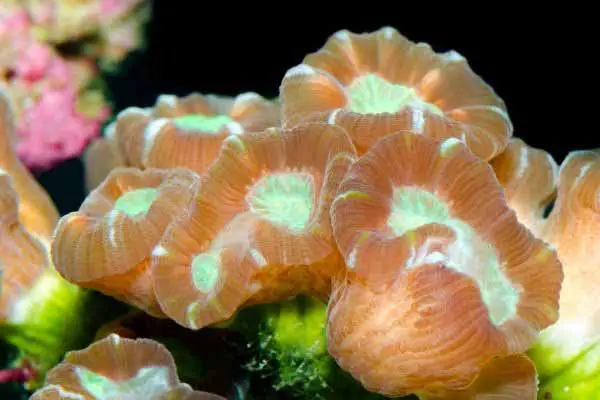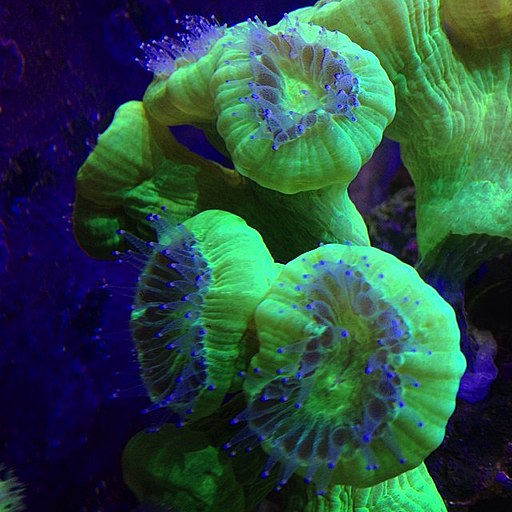The Trumpet Coral is an easy-to-care-for LPS coral, great for beginner and advanced reef tank owners. It is a close cousin to the candy cane coral, and shares a lot of similarities, in terms of care, husbandry, and propagation.
Read on to learn what it takes to care for the trumpet coral in a reef tank and recreate its natural habitat.
Quick Facts About the Trumpet Coral
- Scientific Name: Caulastraea curvata or Caulastraea echinulata
- Common Names: Candy cane, torch, trumpet
- Care Level: Beginner/easy
- Aggression Level: Aggressive – 2-inch sweeper tentacles
- Color: Yellow, Green, & White
- Coral Group: Large Polyp Stony
- Growth Form: Branching
- Key Nutrients: Calcium
Green, neon and purple Trumpet coral varieties
There are a few popular color morphs or trumpet coral varieties available online. The most popular are green, neon, and purple. The green trumpet coral variety is probably the most common, and least expensive. Neon and purple trumpet corals are less common and more expensive.

Natural Habitat
Like many other coral species in the hobby, the Trumpet coral is commonly found in reefs in the Indian and Pacific oceans, specifically in the deeper parts of reef lagoons Sadly, this species has made its way into the vulnerable category of the endangered species list, thanks to pollution and overharvesting.
But there is good news, here, because these beautiful corals are available from aquaculture facilities. Please try to buy aquaculture vs. wild-caught.
Key water parameters for keeping Caulastraea curvata or Caulastraea echinulata
Since the trumpet coral comes from tropical reefs, the best water conditions are those that closely match those of a coral reef:
- Temperature: ~82 degrees Fahrenheit
- Specific gravity: ~1.025
- pH: 8.2
- Alkalinity: 8-12 dkh
- Calcium: ~400 ppm
Read more about: the most important reef aquarium water parameters
Or
Learn more about the test kits and salt mixes used to make and maintain reef-quality water at home
Placement
The trumpet coral is photosynthetic and will generate at least some of its nutrition from your reef tank lighting. But compared with other photosynthetic coral species, their lighting needs are on the moderate-to-low side, which roughly corresponds to placement in the middle of your tank, or lower. They will generally do fine even placed directly in the sandy substrate at the bottom.
As is the case with many of their LPS cousins, the trumpet coral will be aggressive towards competing nearby coral colonies. They have a special type of appendage called a sweeper tentacle, which is generally much longer than their feeding tentacles and will reach out and sting any neighboring coral colonies.
So it is best to place these corals in an area of the tank where they can grow and fill in your tank without coming into close proximity with other species.
It requires some restraint and some forward-looking vision, but even if you’re placing a single polyp or frag in your tank, try to envision the colony filled out, after months or years of growth in your tank….and then add a couple more inches of distance, if you can.
If you are space-constrained, you can still achieve harmony by having a relatively more aggressive fragging plan to keep the colony sized appropriately for the space allowed.
Water flow
Since this coral species has large, fleshy polyps, you will want to keep it in an area of moderate flow–as high flow may be too much and could tear the soft, fleshy polyps.
Lighting
As mentioned above in the placement section (which is correlated with their lighting requirements), trumpet corals will do best with a moderate level of reef aquarium lighting. Too little lighting will starve the poor creatures to death, too much lighting will actually burn them and could cause them to bleach and lose their photosynthetic zooxanthellae.
So best not to place them too high or too directly under the hottest parts of your lights (unless you do not have reef-quality lights, in which case the opposite would be true–you would place them higher and closer to capture the relatively weak light output).
It is always a good idea to acclimate new corals to your lighting by starting them in relatively lower light intensity and gradually increase the intensity over time.
Compatibility
The trumpet coral is a relatively aggressive species, equipped with 2+ inch sweeper tentacles, capable of packing a powerful sting on any neighbors who get a little too close for comfort, like a neighborly Green Star Polyp colony that grows just a little too close for comfort. You should be careful, therefore, to keep an appropriate distance from the other corals in your tank.
LPS corals, like the Caulastraea species, also enjoy being fed meaty foods.

Reproduction & Propagation
One of the most interesting observations about coral species is that they are generally able to reproduce both sexually (release of egg and sperm gametes) and asexually, through a process called fragmenting (fragging for short) or propagation (when the fragmenting is done deliberately to reproduce the colonies.
The release of gametes in a home aquarium is an extremely rare event, but the good news is that fragging and coral propagation is relatively easy-to-do.
This hardy, branching LPS species, is moderately fast-growing and acclimates well to aquarium life.
Since the individual polyps are relatively large, by coral standards, it is relatively easy to propagate this coral by clipping new or fringe polyps around the colony, using bone cutters or a Dremel tool.
The goal, when fragging a large polyp stony species like this, is to cut the colony as close to the bottom of the skeleton as possible, as the top of the skeleton and fleshy polyp are the most sensitive/fragile parts of the animal. Also try to make the cleanest/straightest cut you can, to avoid any chipping away or cracks.
You can learn more about fragging or propagating coral species in my definitive guide, available on Amazon.com
Or
Continue to learn a bit more about fragging corals here.
Feeding
The trumpet coral is a photosynthetic species, which means it has a commensal relationship with tiny, single-celled plant-like organisms called zooxanthellae. These cells are protected by the coral, and in exchange, share some of the sugars they synthesize from the radiation released by your aquarium lights.
While it is possible for photosynthesis to keep your trumpet corals alive, all corals are animals–which means, they eat other things.
As such, it is best to feed your corals periodically (2-3 times/week, at least), when polyps are extended. LPS corals do generally extend their polyps at dawn, dusk, and in the evening, as natural behavior, but you may see happy, hungry Caulastraea curvata corals with their feeding polyps extended for mealtime throughout the day, once acclimated to aquarium life and your preferred feeding schedule.
They eat by stinging and capturing prey with those tentacles and pull the meal inside the body cavity, to be digested.

To manually feed your coral, thaw some Mysis shrimp or brine shrimp and use Sea Squirt or Julian’s Thing to gently deliver the meal right onto the feeding tentacles. If the tentacles are not extended at the time you want to feed them, you can sometimes coax a coral by blasting a small amount of food across the colony and wait a few minutes for the coral to react, before resuming feeding.
Often times, environmental triggers, like turning off internal pumps, can trigger a Pavlovian response akin to ringing the dinner bell, too.
Best to get some experience on your own with some trial and error. The only thing to consider here is to avoid feeding them too much if the tentacles are not exposed. The food will just bounce off and drift to the bottom, becoming food for bristle worms and/or cause spikes in ammonia, nitrites, and nitrates.
Difficulty caring for–or experiencing the trumpet coral dying
Of course, we don’t always experience just success in this hobby. There are a variety of reasons we may not be successful in keeping this great coral or may even have the sad experience of the trumpet coral dying in our tanks.
What does that look like?
Two main reasons the coral may be dying under your care would be disease or starvation–and each would look very different.
Disease
A diseased polyp might have a brown-jelly-look to it. When the coral is truly dying, you may see it dissolve into the water, like a flaky, gross “smoke”.
Starving
A starving coral, by contrast, is a polyp that is slowly struggling to meet its nutritional needs. It might start by acting “shy” and not extending the feeding polyps, the flesh may start to pale and become transparent, and it starts to recede back away from the edges.
Bleached
A bleached coral is one that has expelled its beneficial zooxanthellae and essentially has clear/white polyps. The most common causes of bleaching are:
- The shock from lighting that is too intense
- Dramatic water condition changes (temperature swing, deteriorated water quality, etc.)
How to treat, heal or cure
If your coral is starving –there are two important innovations to consider:
- how to move them into appropriate lighting, and
- finding the right amount of current
- how to get them to accept foods
If caught early, you can sometimes coax corals to eat by turning off pumps at the same time and initiating small puffs of food, spaced a few minutes apart.
Finding the right amount of current is a bit tricky, you want a moderate flow–too much flow may be what is causing them not to expand their polyps.
The intensity of lighting, on the other hand, should slowly adjusted upwards, if possible, by literally dialing up the intensity of the light, for periods of time, over days, or physically moving the coral into the more intense light.
If your coral is truly dying and you see jelly or smoke, remove the dying polyps from the tank. It’s probably too late–but you can explore trying to nurse them back to help in a hospital tank–but don’t leave dying corals in your tank–they can trigger a total tank meltdown. Not trying to freak you out. Just keeping it real.
If only a few branches on a larger colony are dying, you can return the healthy polyps to the tank if you can successfully remove the dying branches.

Trumpet coral for sale
The trumpet coral is not as popular and common as their close cousins, the candy cane coral, but they certainly are available in the hobby. One species, or the other, are likely on a routine order for many local fish stores, and they can certainly be purchased from reputable online retailers, like Saltwaterfish.com, LiveAquaria, BlueZooAquatics and other reputable online retailers.
Cost online varies across the different sites is in the < $30-$150 range, based on colony size, color, etc.
Who is the Trumpet coral best for
It is hopefully no surprise to you, at this point in the article, to hear that the Trumpet coral is an appropriate coral for just about any coral aquarium except those true beginners who have just started their very first saltwater aquarium. I would advise everyone to start out by caring for some hardy saltwater fish before beginning to care for corals, but the trumpet could definitely be in consideration for anyone who has demonstrated some level of success at keeping saltwater aquarium animals alive, looking to expand into stony corals.
For more information
If you want to keep learning, I recommend you continue your journey by reading the following articles:
Or, if you want to check out other large polyp stony corals, check out:



Leave a Reply